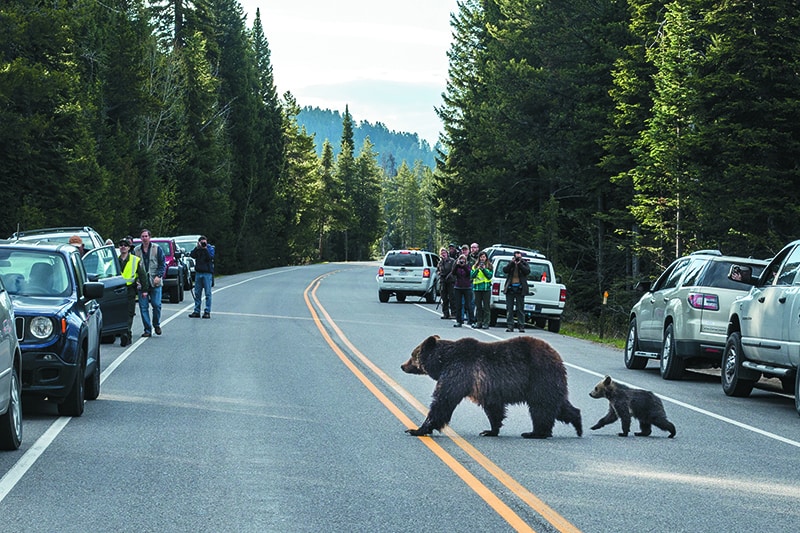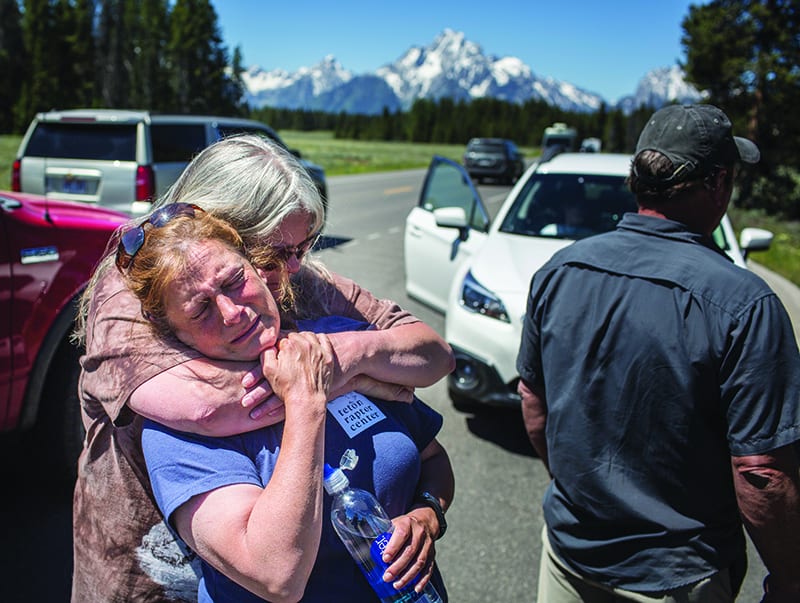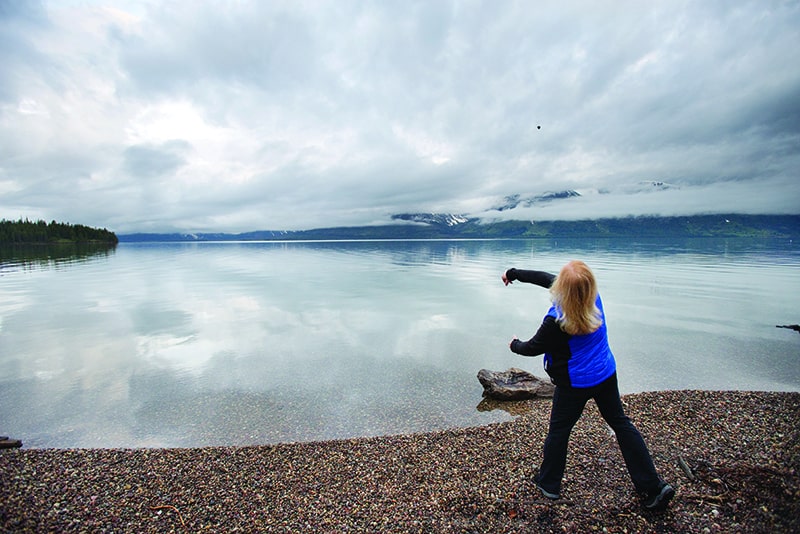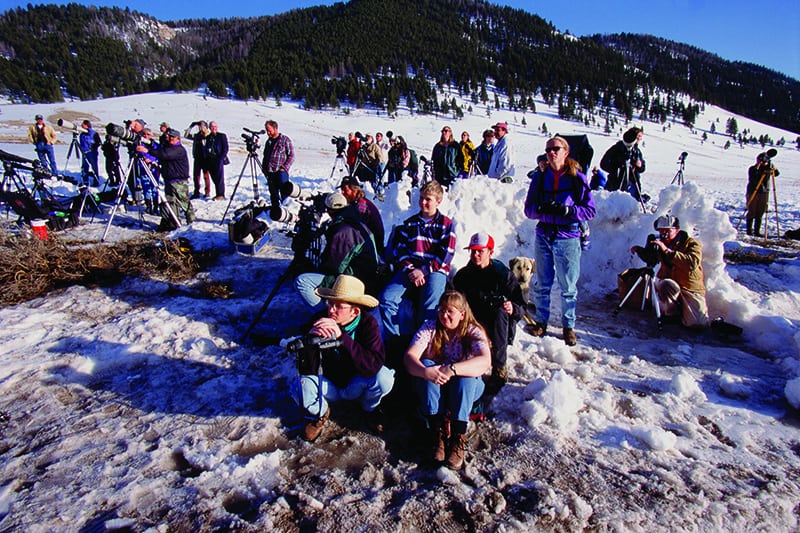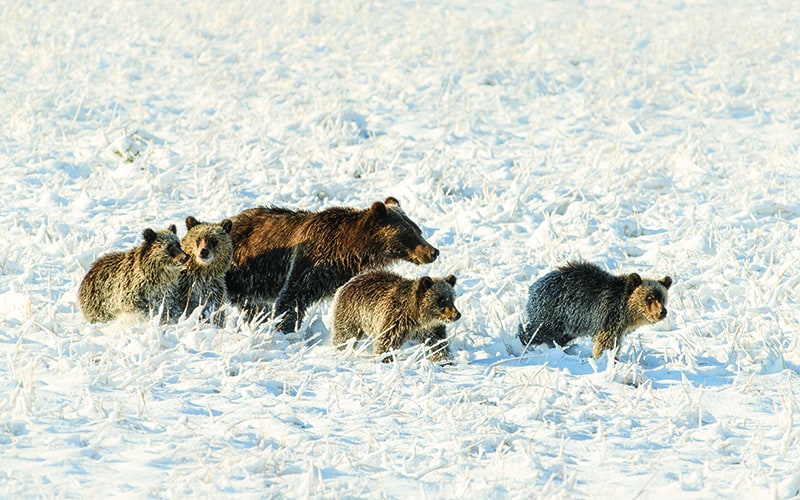Read The
Current Issue
Charismatic individual animals like Grizzly 399 and Wolf 06 are ambassadors for their species, but the celebrity surrounding them isn’t always easy to manage.
By Mike Koshmrl
TEXT MESSAGES FLEW, camera shutters clicked, and social media streamed with scenes of frolicking grizzly bear cubs—cubs who caused cars to be bumper to bumper for the better part of half a mile along Teton Park Road—both sides—on July 17.
All the buzz: Two sow grizzlies, each with cubs, were in the same place at the same time. But these weren’t just any bears, so this wasn’t an ordinary wildlife jam. The spectacle near the Mount Moran turnout was magnified because of the specific bears in sight: Grizzly 399, a twenty-four-year-old matriarch of Grand Teton National Park who has raised seventeen cubs over the past fourteen years, often within eyeshot of park roads; and Grizzly 610, one of 399’s grown daughters. Compounding the excitement over seeing these sows were the six cubs they had between them. Grizzly 399 had four little ones in tow, an extraordinary number of cubs for a grizzly of any age, and 610 had two cubs of her own.
To the delight of the starry-eyed throngs, the estranged mother and daughter grizzlies interacted. “They got close,” veteran wildlife lensman Tom Mangelsen said at the scene. “Three ninety-nine circled around to get downwind of them, then she caught a scent and everything was cool.” While the ursine adults were nonchalant about their reunion, their cubs—aunts and uncles and nieces and nephews, to use human terms—were much more curious. Some of them even played. “Fun to watch,” said Rita Bayles, a naturalist and filmmaker who was leading a photography tour that day. In her SUV’s back seat was a group of Californians. They had come to Grand Teton National Park (GTNP) with one goal: to see its famous grizzly bears, animals like 399, 610, Blondie, Bruno, and the rest of the bunch.
399 and her cubs have made appearances on 60 Minutes. Along with the Cheneys, Harrison Ford, and Kanye, they are as well known as any Wyoming residents.
The National Park Service (NPS) biologists charged with managing the same grizzly bears and the crowds they create hesitate to even utter those numbers and names. To Kate Wilmot, a park biologist and fixture keeping people at a safe distance at bear jams, Grizzly 399 is “sow with four cubs.” This resistance to highlighting specific animals is rooted in some of the foundational principles of wildlife management, like wildlife managers focusing on the population instead of individuals. Gus Smith, GTNP’s science and natural resource chief, explains the rationale. “If I were to be a perfect flat hat [NPS employee], I’d say we want people to be inspired by the wildlife. But I don’t think that the numbers, and this celebrity that we’re talking about, should matter,” he says.
Welcomed or not, the celebrity is real. Grizzly 399 and her kin have an on-the-ground fan club burning tire rubber and shoe leather from whenever the bears emerge from their dens in the spring (April or May) until they disappear again to hibernate through the winter. News of them has appeared in newspapers around the world. They’re the stars of books like Grizzlies of Pilgrim Creek, which features images by Mangelsen and words by Todd Wilkinson, and the recent children’s book simply titled Grizzly 399. Images of them hang in Images of Nature, the downtown-Jackson gallery Mangelsen founded in 1978. Facebook pages, Instagram accounts, hashtags, and bumper stickers exist in their names (numbers). They’ve made appearances on 60 Minutes. Along with the Cheneys, Harrison Ford, and Kanye, they are as well known as any Wyoming residents.
Mangelsen remembers the beginnings of the bears’ icon status. A turning point came in 2011, when both Grizzly 399 and Grizzly 610 came out of their dens with litters of cubs. “We counted 228 different news outlets that covered it,” Mangelsen says. “Jane Goodall called from London and said, ‘One of your bears is in the Sunday paper.’ We found a story from Turkey. That was the beginning of the real fame, I think.” Mangelsen says he never would have guessed that Grand Teton’s grizzlies would become so popular.
YELLOWSTONE NATIONAL PARK senior wildlife biologist Doug Smith (no relation to GTNP’s Gus Smith) isn’t so surprised by recognizable megafauna’s fame. People relate to each other and tell their human histories through stories, he says. It comes naturally that our interpretation of the wild world is also told through stories. What is a key component to any story? The characters involved. After a quarter century researching the world’s most famous wolves, he knows well that the “celebritization” of wildlife can be a conundrum for the agencies involved. “In short, the government hates the naming of things, but the public loves it,” he says. “These animals get a name, whether a number or a humanized name, and a story develops. So what do you do?” Part of the reason agencies are reluctant to embrace celebrity wildlife is because eventually the animals die, and oftentimes humankind is the cause of that death, be it a bullet or bumper. And this is a proven recipe for a blowup.
Outrage over the death of a famous, named animal can reach impressive proportions. Yellowstone’s Doug Smith cites Cecil, a 13-year-old Zimbabwean lion made famous by its Hwange National Park upbringing. When a trophy-hunting dentist from Minnesota struck and killed Cecil with an arrow outside the park five years ago, hell broke loose. Protesters gathered outside the dentist’s shuttered office, and the international media covered the Cecil saga for weeks. There have been similar responses in the Greater Yellowstone Ecosystem. When the alpha female wolf from a Lamar Valley pack known by wolf watchers as 06 was legally shot and killed by a hunter east of Yellowstone—outside of the park—Doug Smith got numerous calls from people who told him he should be fired because he didn’t speak out on her behalf loudly enough. “I also got calls from government people—and I won’t say who, state or federal—saying, ‘You need to calm this down because the wolf lovers are going nuts and it’s on you because you inflamed it,’” he says. “And I didn’t do anything. She got shot, and my phone and my emails started going off the hook.”
Jackson Hole resident Cindy Campbell is one of the people who’s quick to call wildlife professionals when she feels they misstep. One of Teton Park’s grizzly-watching devotees, she appreciates the insight famous bears provide into the everyday management of agencies like the Wyoming Game and Fish Department. “The ambassador bears, we see how they manage them every day because they’re in the public eye,” says Campbell, who isn’t especially fond of the “celebrity” tag. She doesn’t want her ambassadors treated differently, but rather wants to see more compassion brought into the science and decision-making relating to all bears in the Greater Yellowstone Ecosystem. She wants to see bruins set up for success by the decisions of managers but worries that isn’t always happening, based on observations of grizzlies she does know. “In their worlds of bureaucracy, they follow the book,” Campbell says of the agencies. “And it’s time for some new chapters to get written in that book.”
In 2014, the spotlight was on Grizzly 760, a subadult bear born to Grizzly 610 (thus a second-generation descendent of Grizzly 399). Seven-sixty was relocated by the Wyoming Game and Fish Department twice because of habituated behavior; the second time it was hauled across the Greater Yellowstone Ecosystem to near Clark, Wyoming. Shortly after its resettlement here, the young male grizzly pulled down from a tree a deer carcass that had been hung too low by a hunter. This was yet another instance of 760’s habituation—deemed dangerous by Game and Fish—and so the grizzly was trapped and killed. Once the Jackson Hole bear-watching community caught word, outrage and calls for an investigation into wrongdoing were swift. Campbell spearheaded a social media movement and helped organize a memorial on the shores of Jackson Lake the following spring. The gathering was a testimony to the intense passion people can develop for wildlife, especially those they know best. “This should never happen again, ever,” Boulder, Colorado, resident Richard Spratley said from the lakeshore. “Game and Fish can’t do this, ever again. Not to a good bear like that. He was as gentle a soul as you’d ever want to know.”
Wyoming Game and Fish’s large carnivore chief, Dan Thompson, was on the receiving end of the fury at the time. Six years later, he explained that he values a lot of what famous grizzlies like 760 bring to the table. “These animals can generate further interest and awareness in wildlife and wildlife habitats, and provide a glimpse to general laypersons across the world into the importance of all wildlife,” Thompson says. Still, he says the concept of celebrity critters poses a proverbial double-edged sword: When the most famed specimens are lionized, sometimes they become “untouchable”—deified—and can do no wrong in the eyes of some people. “It makes it difficult,” Thompson says. “We get beat up a lot because we talk more about animals on the population level, but that’s what we have to do. We’re not going to conserve all the grizzly bears in the Greater Yellowstone Ecosystem because of one or two bears.” Many—sometimes dozens—of grizzlies are trapped and euthanized every year, whether because they’re hooked on human food and highly habituated, deemed a danger to humans, or are chronically killing livestock (addressing this conflict is a story for another issue).
But wildlife managers like Thompson have sometimes shown a willingness to treat the most famous animals differently. “We’re not stupid,” Thompson says. “We have to realize those [celebrity] bears’ importance.” In 2018, the Endangered Species Act protections had ended for the Yellowstone region’s grizzlies, and the state of Wyoming was pressing forward with the first grizzly bear hunt in nearly four decades. It was immensely divisive and fought over in courts. Game and Fish selected license holders—Mangelsen, armed with his camera, was among them—before a federal judge stepped in at the eleventh hour and halted the hunt. Although the hunt would have allowed up to twenty-two grizzlies to be killed, steps were taken to safeguard the likes of 399, whose home range was part of a no-hunting buffer area adjoining GTNP and Yellowstone. “We devised a regulation that would essentially not allow that particular animal to ever be harvested,” Thompson says. “We protected every place she’s ever lived.” That concession did not placate conservationists like Campbell, who wanted to see all grizzlies treated the same—whether they’re in the public eye or not.
“We get beat up a lot because we talk more about animals on the population level, but that’s what we have to do. We’re not going to conserve all the grizzly bears in the Greater Yellowstone Ecosystem because of one or two bears.”
— WYOMING GAME AND FISH LARGE CARNIVORE CHIEF DAN THOMPSON
IT’S VISIBILITY—PROXIMITY to roads, primarily—that enables the fandom, stardom, and stories that lead to animals developing reputations and names. The dynamics don’t discriminate based on species. “It’s not just limited to the charismatic megafauna, but [with them] it’s a lot more polarized,” Thompson says. When a rarely seen animal, a mountain lion queen, denned and reared her cubs on the flank of the National Elk Refuge’s Miller Butte in 1999, crowds came and watched for months and a moniker resulted: Spirit. People used Spirit to spearhead activism; the roadside scene sparked the formation of the nonprofit Cougar Fund, which is still around two decades later advocating on behalf of mountain lions.
Closely observing the same animals week after week affects people. Oftentimes, it inspires them and makes them want to protect what’s left of the wild. Being around wolves for forty-two years changed Doug Smith’s life (he worked with wolves in Minnesota and Michigan before coming to Yellowstone). “I’ve learned from wolves about how to live life better,” he says. “They’re great parents. They’re infinitely patient. They’re not worried about tomorrow. They live in the moment 100 percent. They could die the next day, and they’re totally fine with it.” In Smith’s view, the future of wildlife conservation and management will continue to be driven by populations, but he also sees merit in recognizing and researching individuals. “For each species it varies, but generally a minority of individuals contribute to the majority of the productivity,” he says. He cited swans and loons, species where roughly 40 percent of the adults are responsible for 80 percent of cygnets and chicks. “What is it about the individuals who do all the contributing that’s different?” he asks. “If you look at it that way, studying individuals becomes really, really important. So why wouldn’t we identify them?”
Doug Smith doesn’t hesitate to say he’s become emotionally invested in individual animals, especially early in his career. Inevitably, he developed favorites, like Wolf 9, an import from Canada who was among the first batch of wolves reintroduced to Yellowstone in 1995. Smith spent time with her in the pen, followed her on horseback and from an airplane, and then one day she just disappeared, which wasn’t easy for him. Wolf 5 was another one; Smith watched her slowly decline due to old age. She began to lag behind her pack, and then one day she went missing. “I flew and flew and flew and flew, and could never get her collar signal,” he says. “And, you know, that one was tough.”
Thompson says he’d pity anyone who happened to accidentally strike and kill a widely cherished animal like Grizzly 399. “I truly believe you’d have to go into witness relocation,” he says. “I don’t know how you’d get out of that.” This past year, the famous grizzly clans of Grand Teton National Park dodged any high-profile deaths through mid-November, though the matriarch—399—and her cubs found themselves in an unprecedented and concerning situation. For much of the late fall, the family was outside of the national park and in the southern valley, where there are subdivisions and ranches. Here they accessed human-related foods: a beekeeper’s honey, livestock feed, and compost. Eating human foods can spell doom for any bear; “a fed bear is a dead bear” is a saying among wildlife biologists and game managers. Once bears associate humans with food, they might spend more time in developed areas, which can lead to unwanted human/bear encounters. When this happens, hazing, relocating and euthanizing bears are all possible outcomes. The fate of grizzly 399 and her four cubs was unclear as this edition of Jackson Hole magazine was sent to the printer.
While they were up in the park, the celebrity grizzlies proved to be more popular than ever, at least anecdotally. Mangelsen says that he and friends at times this past summer counted 200 to 300 vehicles—which likely meant there were several times as many people—at the largest bear jams. These scenes are crowded, chaotic, and a challenge for Wilmot and her team of bear-brigade volunteers to manage, and can be off-putting for people seeking intimate wildlife-watching experiences. At the same time, they’re an opportunity for scores of people to peep their first-ever wild grizzly. GTNP’s Gus Smith sees the wildlife jams as the perfect nexus of the National Park Service’s mission. “It’s protecting the resource for future generations while allowing people to have these amazing experiences,” he says. Mangelsen, who’s watched the crowds swell as the years have passed, says the celebrity grizzly’s growing popularity is a worthwhile tradeoff. “I wish I had the whole park to myself, like everybody else does,” he says. “But this does give a voice to these bears.”
Yellowstone’s Doug Smith understands where fellow wildlife scientists who’ve dug in their heels, refusing to embrace celebrity, are coming from. “A lot of respected colleagues say, ‘Don’t do this,’ because the public fusses about it and the public locks onto it, and it’s all about populations,” he says. “And that is true.” But he believes the celebrity status of wildlife in the ecosystem has helped the cause of conservation. Unlike GTNP staff’s more anonymous treatment of their numbered and recognizable grizzly bears, Yellowstone employees more readily share the research numbers of their wolves with the inquiring public. Former Yellowstone Wolf Project biologist Rick McIntyre, who remains a wolf-watching fixture in the park even though he retired in 2018, was famous for his skillful storytelling of wolves like Wolf 832F—known as 06 by the public. His tales, often told in human terms, inspired connections between people standing at spotting scopes and the named and numbered wolves running wild. “I think the ‘celebritization’ has helped,” Smith says. He explains that well-known individual animals are helping build champions of wildlife and wild places: “I’m not going to say I’m in favor of [celebrity wildlife], but nature needs help. Nature’s declining. We’ve got to connect people with nature, and that’s what the national parks are designed to do. How are we going to do that? You can’t speak in generalities. You’ve got to say, ‘This bear, this wolf, this bison, this elk.’ You need a story, and the naming gives you a story.” JH

